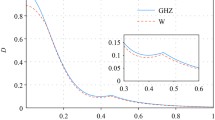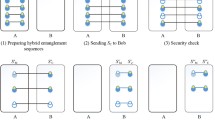Abstract
We analytically prove that the necessary criterion coincides with the sufficient criterion for the full separability of three-qubit Greenberger–Horne–Zeilinger (GHZ) diagonal states. Our result closes the discussion on the separability of three-qubit GHZ diagonal states. Based on the criterion, the corresponding entanglement is exactly calculable for some GHZ diagonal states and is tractable for the others in terms of the relative entropy of entanglement.




Similar content being viewed by others
References
Bell, J.S.: On the Einstein Podolsky Rosen paradox. Physics 1, 195–200 (1964)
Greenberger, D.M., Horne, M.A., Shimony, A., Zeilinger, A.: Bell’s theorem without inequalities. Am. J. Phys. 58, 1131–1143 (1990)
Horodecki, R., Horodecki, P., Horodecki, M., Horodecki, K.: Quantum entanglement. Rev. Mod. Phys. 81, 865–942 (2009)
Gühne, O., Tóth, G.: Entanglement detection. Phys. Rep. 474, 1–75 (2009)
Loss, D., DiVincenzo, D.P.: Quantum computation with quantum dots. Phys. Rev. A 57, 120–126 (1998)
Gaudreau, L., Granger, G., Kim, A., Aers, G.C., Studenkin, S.A.: Coherent control of three-spin states in a triple quantum dot. Nat. Phys. 8, 54–58 (2012)
Monz, T., Schindler, P., Barreiro, J.T., Chwalla, M., et al.: 14-qubit entanglement: creation and coherence. Phys. Rev. Lett. 106, 130506 (2011)
Yao, X.C., Wang, T.X., Xu, P., Lu, H., et al.: Observation of eight photon entanglement. Nat. Photonics 6, 225–228 (2012)
Neeley, M., Bialczak, R.C., Lenander, M., Lucero, E., et al.: Generation of three-qubit entangled states using superconducting phase qubits. Nature 467, 570–573 (2010)
DiCarlo, L., Reed, M.D., Sun, L., Johnson, B.R., et al.: Preparation and measurement of three-qubit entanglement in a superconducting circuit. Nature 467, 574–578 (2010)
Neumann, P., Mizuochi, N., Rempp, F., Hemmer, P., et al.: Multipartite entanglement among single spins in diamond. Science 320, 1326–1329 (2008)
Dür, W., Cirac, J.I.: Classification of multiqubit mixed states: separability and distillability properties. Phys. Rev. A 61, 042314 (2000)
Gühne, O., Seevinck, M.: Separability criteria for genuine multiparticle entanglement. New J. Phys. 12, 053002 (2010)
Jungnitsch, B., Moroder, T., Gühne, O.: Taming multiparticle entanglement. Phys. Rev. Lett. 106, 190502 (2011)
Doherty, A.C., Parrilo, P.A., Spedalieri, F.M.: Distinguishing separable and entangled states. Phys. Rev. Lett. 88, 187904 (2002)
Huber, M., Mintert, F., Gabriel, A., Hiesmayr, B.C.: Detection of high-dimensional genuine multipartite entanglement of mixed states. Phys. Rev. Lett. 104, 210501 (2010)
Eltschka, C., Siewert, J.: Entanglement of three-qubit Greenberger–Horne–Zeilinger symmetric states. Phys. Rev. Lett. 108, 020502 (2012)
Kay, A.: Optimal detection of entanglement in Greenberger–Horne–Zeilinger states. Phys. Rev. A 83, 020303(R) (2011)
Gühne, O.: Entanglement criteria and full separability of multi-qubit quantum states. Phys. Lett. A 375, 406–410 (2011)
Vedral, V., Plenio, M.B., Rippin, M.A., Knight, P.L.: Quantifying entanglement. Phys. Rev. Lett. 78, 2275–2279 (1997)
Aschauer, H., Dür, W., Briegel, H.-J.: Multiparticle entanglement purification for two-colorable graph states. Phys. Rev. A 71, 012319 (2005)
Acknowledgments
The authors thank the support of the National Natural Science Foundation of China (Grant No. 11375152).
Author information
Authors and Affiliations
Corresponding author
Appendices
Appendix 1: Proof of Eqs. (17) and (18)
The definition of \(C(\overrightarrow{X})\) in Eq. (12) leads to the solutions of the angles \(a,b,c\) as functions of the parameters \(\delta ,\alpha ,\beta ,\gamma ,\) namely [19],
with \(Q=-(\alpha \beta \delta +\alpha \beta \gamma -\alpha \gamma \delta -\beta \gamma \delta ) (\alpha \beta \delta -\alpha \beta \gamma +\alpha \gamma \delta -\beta \gamma \delta ) (\alpha \beta \delta -\alpha \beta \gamma -\alpha \gamma \delta +\beta \gamma \delta ) (\alpha \beta \delta +\alpha \beta \gamma +\alpha \gamma \delta +\beta \gamma \delta ), R=\alpha \beta \gamma \delta (\alpha \beta -\gamma \delta ) (\alpha \gamma -\beta \delta ) (\alpha \delta -\beta \gamma )\). Let us consider the derivative \(\frac{\partial C(\overrightarrow{X})}{\partial \alpha },\) we have
Using (13), we have \(\frac{\partial C(\overrightarrow{X})}{\partial \alpha }=\alpha \sin a(\frac{\partial d}{\partial \alpha }-\frac{\partial a}{ \partial \alpha }-\frac{\partial b}{\partial \alpha }-\frac{\partial c}{ \partial \alpha })+\cos a\). Since \(d\equiv a+b+c,\) we have
similarly, \(\frac{\partial C(\overrightarrow{X})}{\partial \beta }=\cos b, \frac{\partial C(\overrightarrow{X})}{\partial \gamma }=\cos c\) and \(\frac{ \partial C(\overrightarrow{X})}{\partial \delta }=\cos d\).
Appendix 2: Closest separable state of GHZ diagonal state
Up to local Hadamard transformations, the \(\left| \hbox {GHZ}_k\right\rangle \) basis is equivalent to the graph state basis \(\left| G_\mu \right\rangle \) (\(\mu =\mu _1\mu _2\mu _3\) with \(\mu _i=0,1\)). For any state \(\sigma =\sum _{\mu ,\nu }q_{\mu \nu }\left| G_\mu \right\rangle \left\langle G_\nu \right| \), which may not be diagonal in the graph state basis, it is always possible to convert \(\sigma \), via local probabilistic operations, into a graph diagonal state \(\sigma _d=\sum _\mu q_{\mu \mu }\left| G_\mu \right\rangle \left\langle G_\mu \right| \)with the same diagonal elements [21]. So, if \(\sigma \) is fully separable, then \(\sigma _d\) is also fully separable since the local conversion to a diagonal state cannot introduce entanglement.
On the other hand, we use the fact that the function \(-\log x\) is convex which results in
for any operator \(A\) and any normalized state \(\left| \phi \right\rangle \) (see Ref. [20]). In the derivation, the spectrum decomposition of operator \(A\) is utilized. The relative entropy of a graph diagonal state \(\rho =\sum _\mu p_\mu \left| G_\mu \right\rangle \left\langle G_\mu \right| \) with respect to a fully separable state \(\sigma \) is
Thus, for any fully separable state \(\sigma \), we can always find a graph diagonal fully separable state \(\sigma _d\) such that the relative entropy \( S(\rho ||\sigma )\) is lower bounded by the relative entropy \(S(\rho ||\sigma _d)\). The closest fully separable state of an entangled graph diagonal state is a graph diagonal state.
Rights and permissions
About this article
Cite this article
Chen, Xy., Jiang, Lz., Yu, P. et al. Necessary and sufficient fully separable criterion and entanglement of three-qubit Greenberger–Horne–Zeilinger diagonal states. Quantum Inf Process 14, 2463–2476 (2015). https://doi.org/10.1007/s11128-015-0990-4
Received:
Accepted:
Published:
Issue Date:
DOI: https://doi.org/10.1007/s11128-015-0990-4




